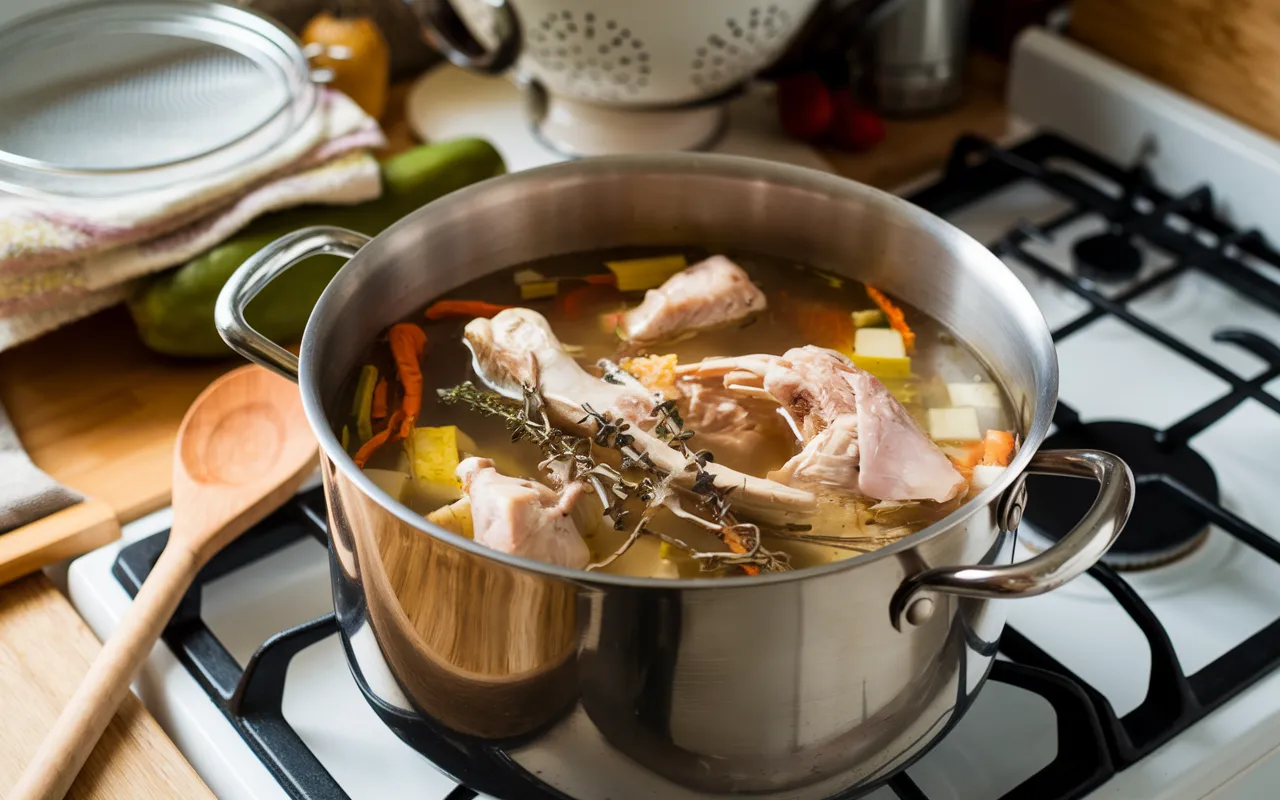Rotisserie chicken scraps are often overlooked treasures that can be transformed into delicious, economical, and eco-friendly dishes. From making hearty stocks to crafting casseroles bursting with flavor, these leftovers are versatile and packed with potential. In this guide, you’ll learn creative ways to make the most of every bit of your rotisserie chicken while reducing food waste. Let’s dive in and explore these brilliant ideas, starting with the basics.
Understanding the Value of Rotisserie Chicken Scraps
Understanding the Value of Rotisserie Chicken Scraps
When you pick up a rotisserie chicken for a quick dinner, the meat is only part of the package. The remaining chicken carcass, bones, and skin are culinary goldmines waiting to be tapped. These scraps hold rich flavors that can elevate your cooking, especially when you’re making stocks, soups, or sauces.
Why You Shouldn’t Discard Chicken Scraps
Throwing away rotisserie chicken scraps is like tossing out free ingredients! They are perfect for creating homemade chicken stock, which forms the foundation of countless recipes. Not only do these scraps add depth to your dishes, but they also help you save money. Why spend extra on store-bought broths when you can whip up a fresh batch at home?
The Nutritional and Culinary Advantages
Rotisserie chicken scraps aren’t just about taste; they’re also nutritious. Bones are rich in collagen, which is great for making bone broth. This nutrient-packed liquid supports joint health and is a comforting base for soups and stews. Plus, you’re embracing a sustainable approach by reducing food waste and maximizing the chicken’s value.
Making Homemade Chicken Stock
Preparing Chicken Stock from Rotisserie Chicken Carcasses
Making chicken stock from rotisserie chicken carcasses is a brilliant way to extract every bit of flavor and nutrition. The chicken bones, along with any scraps of meat and skin, contain collagen and fats that enrich your stock. To begin, collect the carcasses after your meal. If you’re not ready to use them right away, freeze them in an airtight bag or container for later.
When preparing stock, use a large pot to allow the ingredients to simmer evenly. The slow cooking process extracts maximum flavor and nutrients, transforming what many consider waste into liquid gold.
Essential Ingredients for Flavorful Chicken Stock
The key to a delicious chicken stock lies in the supporting ingredients. While rotisserie chicken carcasses provide the base, a few kitchen staples elevate the taste:
- Vegetables: Carrots, celery, and onions are a classic trio for flavor.
- Herbs and Spices: Add parsley, bay leaves, thyme, and whole peppercorns for an aromatic touch.
- Acid: A splash of vinegar or lemon juice helps extract collagen from the bones.
Avoid adding salt at this stage. Salt can concentrate as the stock reduces, so it’s better to season it during cooking.
Optional Add-Ins
For a richer taste, toss in garlic cloves, leeks, or leftover vegetable scraps. These deepen the stock’s complexity without extra cost.
Step-by-Step Guide to Making Chicken Stock
Creating homemade chicken stock is simple, but patience is key. Here’s how to get started:
- Gather Your Ingredients: Combine rotisserie chicken carcasses, vegetables, and herbs in a large stockpot.
- Add Water: Cover the ingredients with cold water, leaving some space at the top to prevent boiling over.
- Simmer, Don’t Boil: Bring the pot to a gentle simmer over medium heat. Skim off any foam that forms on the surface to keep the stock clear.
- Cook Low and Slow: Simmer for 4-6 hours. The longer it cooks, the deeper the flavor becomes.
- Strain the Stock: Use a fine-mesh sieve to separate the liquid from the solids. Discard the bones and vegetables after straining.
- Cool Quickly: Place the strained stock in an ice bath to cool it rapidly before storing. This step prevents bacterial growth.
Storing and Preserving Homemade Chicken Stock
Proper storage ensures that your chicken stock stays fresh and ready for use.
Refrigeration:
Let the stock cool completely, then transfer it to airtight containers or jars. It will last up to five days in the refrigerator.
Freezing:
For longer storage, freeze the stock in portioned containers or silicone ice cube trays for easy use. Label them with the date and quantity for convenience. Stock can be frozen for up to six months.
Defatting the Stock:
Once chilled, you’ll notice a layer of fat forming on top. This can be skimmed off and used as schmaltz (chicken fat) in cooking, or discarded if you prefer a leaner stock.
With these steps, you’ll have flavorful, homemade chicken stock ready to enhance your soups, stews, and sauces.
Creating Chicken Broth and Bone Broth
Differences Between Chicken Stock, Broth, and Bone Broth
Although they might seem interchangeable, chicken stock, broth, and bone broth are distinct in preparation and purpose. Understanding these differences can help you choose the best option for your cooking needs.
Chicken Stock
Chicken stock is made primarily from bones and is cooked for several hours. The bones release collagen, giving the stock a rich, gelatinous texture. It serves as a base for soups, sauces, and stews where depth of flavor is key.
Chicken Broth
Broth is typically made from meat rather than bones. It has a lighter flavor and thinner consistency, making it perfect for sipping or as a base for lighter dishes like clear soups and rice dishes.
Bone Broth
Bone broth is made by simmering bones for an extended period—sometimes up to 24 hours. This process extracts maximum nutrients like collagen, minerals, and amino acids. It’s prized for its health benefits, including joint and skin support.
Making Chicken Broth Using Rotisserie Chicken Leftovers
Chicken broth is simple to prepare using the rotisserie chicken leftovers you already have on hand. Unlike stock, broth relies on the meat rather than just the bones. Here’s how to make it:
Ingredients Needed:
- Leftover rotisserie chicken meat and skin
- Water (enough to cover the ingredients)
- Aromatic vegetables (carrots, celery, onions)
- Fresh herbs (parsley, dill, thyme)
- Salt and pepper to taste
Steps to Make Chicken Broth:
- Add Chicken and Vegetables: Place the meat, skin, and vegetables in a pot.
- Cover with Water: Fill the pot with water, ensuring all ingredients are submerged.
- Bring to a Simmer: Heat on medium until it reaches a gentle simmer.
- Cook for 1-2 Hours: Let the broth simmer uncovered, allowing flavors to meld.
- Strain and Season: Remove solids using a fine sieve, then season the liquid to your preference.
This broth can be enjoyed on its own or used to enhance dishes like soups, risottos, and stir-fries.
Preparing Nutritious Bone Broth from Chicken Bones
Bone broth has gained popularity for its health-boosting properties, and rotisserie chicken bones are perfect for making this nutrient-packed elixir.
Ingredients for Bone Broth:
- Rotisserie chicken bones (and any additional chicken feet or wings for extra collagen)
- Water (enough to cover bones)
- Vinegar or lemon juice (to help extract minerals)
- Aromatic vegetables (carrots, celery, onions, garlic)
- Bay leaves, thyme, and parsley
Steps to Prepare Bone Broth:
- Prepare the Bones: Break the chicken carcass into smaller sections.
- Add to Pot: Place the bones in a large stockpot with vegetables, herbs, and acid (vinegar or lemon juice).
- Simmer for Hours: Cover with water and cook on low for 12–24 hours. The extended cooking time extracts nutrients and collagen.
- Skim Occasionally: Remove any foam or impurities that rise to the surface.
- Strain and Store: Strain the broth, discarding solids, and store the liquid in airtight containers.
Health Benefits of Bone Broth:
This broth is rich in collagen, which supports joint health, skin elasticity, and gut health. Its soothing properties make it ideal for sipping as a warm drink or using as a base for nourishing recipes.
Culinary Uses for Rotisserie Chicken Scraps
Incorporating Leftover Chicken into Soups and Stews
Transforming rotisserie chicken leftovers into hearty soups and stews is one of the simplest ways to create a comforting meal. The tender, flavorful meat pairs perfectly with fresh vegetables, grains, and legumes. These dishes are not only delicious but also ideal for meal prep or feeding a crowd.
Soup Ideas with Leftover Chicken
- Classic Chicken Noodle Soup: Combine shredded chicken with broth, noodles, carrots, and celery for a timeless dish.
- Chicken Tortilla Soup: Add chicken to a spicy broth with tomatoes, black beans, and corn, topped with crispy tortilla strips.
- Creamy Chicken and Rice Soup: Blend chicken with cream, rice, and hearty vegetables for a rich and satisfying option.
Stew Ideas with Chicken Scraps
- Chicken and Lentil Stew: Use chicken pieces with lentils, spinach, and warm spices for a nutritious meal.
- Thai Chicken Curry Stew: Combine leftover chicken with coconut milk, curry paste, and vegetables for a vibrant, flavorful dish.
Enhancing Casseroles and Pasta Dishes with Shredded Chicken
Casseroles and pasta dishes are ideal for using shredded rotisserie chicken. These meals are easy to assemble, incredibly versatile, and often crowd-pleasers.
Casserole Ideas with Rotisserie Chicken
- Chicken and Broccoli Casserole: Combine shredded chicken, steamed broccoli, creamy sauce, and cheese, then bake until golden.
- Mexican Chicken Casserole: Layer chicken with salsa, tortillas, and cheese for a zesty, comforting dish.
- Chicken and Wild Rice Bake: Mix chicken with wild rice, mushrooms, and a creamy base for a hearty option.
Pasta Dishes with Leftover Chicken
- Chicken Alfredo Pasta: Toss shredded chicken with creamy Alfredo sauce and your favorite pasta for a quick meal.
- Chicken Pesto Pasta: Combine chicken with pesto, cherry tomatoes, and spinach over penne or fettuccine.
- Chicken Lasagna: Replace beef with chicken in your lasagna layers for a lighter twist on the classic.
Creating Flavorful Salads and Sandwiches with Leftover Chicken
Light, refreshing, and quick to prepare, salads and sandwiches are excellent ways to use rotisserie chicken scraps. These options are perfect for lunch or a healthy dinner.
Salad Ideas with Rotisserie Chicken
- Classic Chicken Caesar Salad: Toss chicken with romaine, croutons, Parmesan, and Caesar dressing.
- Greek Chicken Salad: Combine chicken with cucumbers, tomatoes, feta, olives, and a tangy vinaigrette.
- Asian Chicken Salad: Use chicken with shredded cabbage, carrots, sesame seeds, and a ginger-soy dressing for a bold flavor profile.
Sandwich Ideas with Leftover Chicken
- Chicken Salad Sandwich: Mix shredded chicken with mayo, celery, and a touch of mustard, and serve on crusty bread.
- BBQ Chicken Sliders: Toss chicken in barbecue sauce and serve on mini buns for a quick snack or meal.
- Grilled Chicken Panini: Layer chicken, mozzarella, spinach, and pesto between two slices of bread, then press until crispy.
Additional Creative Uses
Making Chicken Fat (Schmaltz) for Cooking
Chicken fat, also known as schmaltz, is a flavorful byproduct of rotisserie chicken scraps that can elevate your cooking. Extracting schmaltz from the chicken skin or fat is simple and yields a versatile ingredient ideal for frying or enhancing dishes.
How to Make Schmaltz
- Collect the Fat and Skin: Save the fatty scraps and skin from your rotisserie chicken.
- Render the Fat: Place the pieces in a skillet over low heat, allowing the fat to melt and separate from the solids.
- Strain the Schmaltz: Pour the liquid fat through a fine mesh strainer into a heatproof container.
Schmaltz adds depth to mashed potatoes, roasted vegetables, and even homemade matzo ball soup. It can be stored in the fridge for weeks or frozen for longer use.
Utilizing Chicken Skin for Crispy Garnishes
Don’t let that chicken skin go to waste! With a little effort, you can turn it into crispy garnishes that add texture and flavor to various dishes.
Steps to Make Crispy Chicken Skin
- Prepare the Skin: Lay the chicken skin flat on a baking sheet lined with parchment paper.
- Season: Sprinkle with salt, pepper, or your favorite spices.
- Bake: Roast in a preheated oven at 375°F (190°C) for 10–15 minutes until golden and crispy.
Serving Ideas
- On Salads: Crumble crispy chicken skin over greens for added crunch.
- In Soups: Use it as a topping for chicken noodle soup.
- As a Snack: Enjoy it on its own as a savory treat.
Composting Chicken Bones and Scraps
If you’ve used your rotisserie chicken scraps to the fullest, composting is an eco-friendly way to ensure nothing goes to waste. While cooked bones can’t always go into standard compost bins, they can be managed with specific techniques.
Steps for Composting Chicken Bones
- Break Them Down: Crush or grind the bones into smaller pieces to speed up decomposition.
- Add to Compost: Mix the bones with greens (vegetable scraps) and browns (leaves, cardboard) in a compost bin.
- Monitor and Turn: Regularly turn the compost to maintain airflow and support decomposition.
Alternative Uses for Bones
If composting isn’t an option, consider burying the bones in your garden soil. Over time, they’ll break down and enrich the soil with calcium and other minerals, benefiting your plants.
Frequently Asked Questions
FAQs on Using Rotisserie Chicken Scraps
Using rotisserie chicken scraps is a resourceful way to reduce waste and elevate your cooking. Here are answers to some of the most common questions about maximizing your leftovers:
How long can I store chicken stock in the refrigerator?
Homemade chicken stock can be stored in the refrigerator for up to five days. To keep it fresh longer, ensure it cools completely before sealing it in airtight containers. For extended storage, freezing is the best option.
Can I freeze chicken bones for future stock-making?
Absolutely! Chicken bones freeze well and can be stored for several months. Place them in a resealable freezer bag, ensuring all air is removed, and label the bag with the date. This way, you’ll always have bones ready for stock when you need them.
What vegetables are best for making chicken stock?
The classic trio of onions, carrots, and celery works wonders for chicken stock. Garlic, leeks, and parsley stems are also excellent additions for flavor. Avoid starchy vegetables like potatoes, as they can make the stock cloudy.
How can I reduce the fat content in homemade chicken broth?
After refrigerating your broth, you’ll notice a layer of fat solidifying on the surface. This can be easily skimmed off with a spoon to create a leaner broth. Alternatively, use a fat separator when straining the broth to remove excess grease.
Is it safe to use chicken bones that have been previously frozen?
Yes, it is safe to use frozen chicken bones, as long as they were stored properly. Thaw them in the refrigerator overnight before making stock to ensure even cooking.
What are the health benefits of bone broth?
Bone broth is rich in collagen, amino acids, and minerals, which can promote joint health, improve skin elasticity, and support gut health. Its soothing properties also make it an excellent remedy for colds and flu.
Conclusion
Maximizing the Use of Rotisserie Chicken Scraps for Sustainable Cooking
Rotisserie chicken scraps are a hidden treasure that can inspire a range of flavorful and sustainable dishes. From making nutrient-rich chicken stock and versatile broths to creating crispy garnishes and composting bones for your garden, the possibilities are nearly endless. By utilizing every part of the chicken, you not only reduce food waste but also save money and enhance the quality of your meals.
Incorporating these scraps into soups, casseroles, salads, and even garnishes allows you to stretch your ingredients further while embracing a more eco-friendly kitchen. Plus, the added nutritional benefits from bone broth and schmaltz make these efforts worthwhile for your health.
Sustainable cooking starts with small changes like rethinking leftovers, and rotisserie chicken scraps are the perfect place to begin. With creativity and resourcefulness, you can transform what might otherwise be discarded into delicious and meaningful meals that everyone will enjoy.


